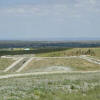By Bob Reece

Photos © Bob Reece unless
otherwise noted

The winning design
for the Indian Memorial was selected from over 500 submitted, by the
public, for review by the Indian Memorial Committee. The designers,
John Collins
and Alison Towers, provided a simple but elegant yet symbolic concept
that has proven quite popular to the hundreds of thousands of visitors
each year at Little Bighorn. The Indian Memorial will surprise you.
It will
astonish you because if you didn't know it, you wouldn't know it's
there. From the visitor center it appears to be a mound, slightly
lifted above the ground. There is already prairie grass sprouting from
the outside walls blending it beautifully within its environment.
You cross the street from Last Stand Hill and the
first thing you come to is the wayside for Wooden Leg Hill and the
Unknown Warrior marker on a distant ridge. Wooden Leg witnessed the
death of an unknown warrior wearing a warbonnet when he was shot
through the head.
From there you turn northwest and pass by the
Horse Cemetery with the new marble marker including a 7th Cavalry
Horse drawn by Park Historian, John Doerner. There is a wayside
exhibit explaining the archeological dig that was conducted there.
From there you follow the sidewalk to where it forks going east and
west. The proper way to enter the Memorial is from the east entrance
and exit from the west. As you approach the memorial it begins to
swallow you into its power. It becomes taller and more mysterious. As
you approach the east entrance of the Memorial you can see just above
the mound the very tops of the Spirit Warriors (see photos below).
When you enter the Memorial, you enter another
world -- somber, deep, retrospective, and sacred. The Memorial is in
the shape of a perfect circle. In the center is a circle of red dirt.
Around it is a circled stone walkway. On the inner walls sit panels
for each tribe that fought in the battle (Sioux, Cheyenne, Arapaho,
Crow, Arikara). Each tribe lists their dead and there are some
pictographs.
You are immediately taken by the Spirit Warriors
standing high above you to the north. The area is wide open so the
Montana prairie shines through. If you turn around from the Spirit
Warriors you look through a gap in the mound called the Weeping Wall.
It is here that water continually trickles down into a pool
representing tears for the fallen warriors and soldiers. And, centered
perfectly within the Weeping Wall can be seen the 7th Cavalry
Monument. This Spirit Gate welcomes the fallen soldiers to enter the
Memorial and join the fallen warriors in friendship; “peace through
unity.” Its symbolism is powerful in so many ways to say the least.
It is peaceful in this place, within this circle. When I stand inside
the Memorial I feel that it has always been there but is just now
showing itself.
The Panels
Photos © Joanne
Blair
Along the walls inside the Indian Memorial are
panels for each tribe that fought in the battle: Sioux, Cheyenne,
Arapaho, Crow and Arikara. Below are photos of these panels.
Imagine if you will that you've entered the memorial from the east and
now standing in the center of the memorial. You turn around facing
east and the first panel you see is for the Crow just to the left of
the east entrance. These photos are arranged in the order you would
see them if you started looking right completing the full circle with
the Arikara panel.
|
|

|
|
The Crow -- Spirit Warriors to the left
|
|

|
|
The Cheyenne
|
|

|
|
A list of Cheyenne fallen and the five Arapaho's who fought in the battle
|
|

|
|
Cheyenne & Arapaho continued
|
|
|
|

|
|
The Sioux -- The Weeping Wall is directly to the left
|
|

|
|
The Sioux continued
|
|

|
|
A list of the Sioux dead
|
|

|
|
The Sioux continued -- West exit to the right
|
|
|
|

|
|
The Arikara and their dead -- Spirit Warriors to the right
|
|
|
A Closer Look At Some Of The Panels
Photos below © Kris Nyström
Photos below © Jim
Eshleman,
Hardin Photo, Hardin, MT.
406-665-2800
Webmaster's Note: Jim
Eshleman is gracious to let us use his photos of the inside of the Indian
Memorial. I think you would agree that these include some of the most
unique perspectives seen of any photos so far of the memorial.
(Back
to Top)
|















































